What Type of Space Heater is Most Energy Efficient: A Comprehensive Guide
This article analyzes the most energy efficient types of space heaters, focusing on how their heat transfer mechanisms can effectively warm spaces with minimal energy usage.
This most efficient types of space heater are the ceramic, infrared, oil-filled and convection space heater model types and we will compare their typical wattage needs, suitable room sizes and efficiency advantages.
Understanding a heater’s design, features and proper sizing is key to selecting the optimal option for your needs while saving energy and lowering costs.
Most Energy Efficient Space Heater Types
In this section, we will discuss four types of energy efficient space heaters that can help you keep your home warm and cozy while conserving energy.

Ceramic Space Heaters
Ceramic space heaters utilize ceramic plates to absorb and then radiate heat throughout a room. These heaters are particularly suitable for small spaces, as they can efficiently maintain the desired temperature.
On average, a typical ceramic space heater uses between 750 watts and 1500 watts of power when in use. More powerful models may use up to 1500 watts.
To put this in perspective, a 750 watt ceramic space heater would use about the same amount of energy as 3-4 standard 60-watt light bulbs.
The amount of energy used per hour can be calculated by multiplying the wattage by the number of hours used. So a 1000 watt ceramic space heater running for 4 hours would use about 4 kilowatt-hours (1000 x 4 = 4000 watt-hours = 4 kWh) of energy.
Energy usage also depends on settings. Ceramic space heaters usually have low, medium, and high heat settings. Running it on low will use less energy than high.
Smaller ceramic heaters of 500-750 watts are generally sufficient to heat a room up to 200-300 square feet. Larger rooms may require a more powerful 1000-1500 watt model.
However, it is important to note that ceramic space heaters may not be suitable for larger rooms requiring prolonged heating periods, as they need to remain switched on continuously for optimum functioning.
Infrared Space Heaters
Infrared heaters work by emitting infrared waves similar to natural heat from the sun to directly warm objects and people, rather than heating the air.
They tend to be more energy efficient than conventional fan heaters because they directly transfer heat instead of relying on air circulation. Infrared heat also distributes evenly without drafts.
Most portable infrared space heaters have a wattage rating between 250-1500 watts, similar to ceramic space heaters. Smaller tabletop models are around 250-750 watts.
At maximum power, a 1000 watt infrared space heater would use approximately the same amount of energy per hour as a 1000 watt ceramic space heater – about 1 kWh per 4 hours of continuous use.
However, infrared heaters often have adjustable settings that allow lowering wattage use. For example, a 1000 watt model on low may use as little as 250 watts.
Properly sized, a 250-750 watt infrared space heater can comfortably heat spaces up to around 150-250 square feet.
Whole-room infrared panel heaters mounted high on walls may use 1500 watts or more but efficiently heat larger areas.
Oil-Filled Space Heaters
Oil-filled space heaters are filled with thermal oil, which is heated by an electric element. Once heated, the oil retains its warmth and evenly distributes the heat through natural convection.
Oil-filled space heaters tend to have lower wattage ratings than ceramic or infrared heaters, ranging from approximately 500-1500 watts.
The steady, radiant heat produced is very energy efficient. A 1500 watt oil-filled heater may heat as effectively as a 2000 watt fan heater.
At lower settings, efficient oil-filled heaters may use as little as 500 watts. Higher settings increase consumption up to their full wattage rating.
Despite lower wattage, oil-filled heaters can evenly heat large spaces very efficiently due to their steady, radiant heating technology.
A 500-1000 watt model is suitable for spaces 150-300 sqft. Larger 1500 watt heaters work for areas up to 500 sqft.
Energy usage per hour can be estimated as watts x hours. So a 1000 watt heater running 8 hours would use around 8,000 watt-hours or 8 kWh.
In summary, oil-filled heaters tend to have lower wattage ratings but produce steady, efficient radiant heat suitable for heating larger areas while using less energy than comparable fan heaters. Proper sizing is important for optimal efficiency.
Convection Heaters
Convection heaters work by circulating warm air throughout a room, providing an even and consistent heat distribution. These heaters can be an ideal choice for spacious rooms or larger areas that require consistent heat. Some features of convection heaters include:
Convection space heater wattage ratings are generally higher than oil-filled or infrared heaters, ranging from about 1000-2500 watts for portable models.
At maximum output, a 2000 watt convection heater would consume about 2 kWh of energy per 4 hours of continuous use.
However, convection heaters are less energy efficient than radiant heaters because they rely on inefficient air movement versus direct heat transfer.
Fan settings can impact efficiency – low/medium fans use less energy than a high fan setting for the same heat output.
They work best for small, well-insulated spaces up to about 150-250 sqft. Larger units may handle 250-400 sqft.
Built-in thermostats and timers can help regulate runtime to minimize wasted energy from overheating.
Proper placement near the floor maximizes circulation without over-warming overhead space.
In summary, convection heaters have higher wattage needs but integrating efficient fan settings and thermostats can improve energy usage. Sizing appropriately also prevents wasting energy heating unoccupied areas.
Understanding Energy Efficiency in Space Heaters
Energy efficiency refers to the ability of a device or appliance to perform its function with minimal energy consumption. In the case of space heaters, energy-efficient models are those that can provide the desired warmth while using the least amount of energy.
This is not only good for the environment but can also help you save on your electricity bills.
Importance of Energy Efficiency
Improving energy efficiency in space heaters is essential for several reasons:
- Cost savings: Energy-efficient heaters typically cost less to operate, which can result in significant savings on your energy bills over time.
- Environmental impact: Reducing energy consumption contributes to lower greenhouse gas emissions and helps combat climate change.
- Resource conservation: Using energy more efficiently means reducing our reliance on non-renewable energy sources, such as fossil fuels.
Measurement Units for Energy Efficiency
There are different metrics used to measure the energy efficiency of a space heater.
Some common units include:
- Watts: This measures the heater’s power consumption. Lower wattage indicates a more energy-efficient heater.
- BTU (British Thermal Unit): This represents the amount of heat a heater can produce. The higher the BTUs, the more heat a heater can generate.
- EER (Energy Efficiency Ratio): This ratio helps compare the effectiveness of different heaters by displaying the BTU per watt-hour. A higher EER indicates greater energy efficiency.
When choosing a space heater, it’s crucial to consider not only the heater’s wattage and BTUs but also its EER. To find the most energy-efficient space heater for your needs, compare models with similar wattage and BTU ratings, and select the one with the highest EER.
Remember, always refer to a trusted source such as energy.gov to find up-to-date information and recommendations on energy-efficient space heaters.
Analyzing Heat Transfer Methods
The three main heat transfer methods are conduction, convection, and radiation. Conduction requires direct contact and isn’t practical for space heating.
Convection involves warm air circulation. Ceramic and oil-filled heaters are convection examples. They maintain consistent temperatures efficiently and quietly. Popular convection options include the Lasko Electric Oscillating Ceramic Tower and LifeSmart Infrared Quartz Fireplace.
Radiation uses infrared heat to directly warm objects and people in view, providing quick warmth. Infrared space heaters like the Dr. Infrared Portable Heater and Heat Storm HS-1500 radiate heat efficiently.
Convection heaters are best for steady temperature control. Radiant heaters offer targeted, rapid warmth. Understanding these heat transfer mechanisms helps select the most suitable, energy-efficient space heater for your needs.
How Space Heater Design and Size Affect Energy Efficiency
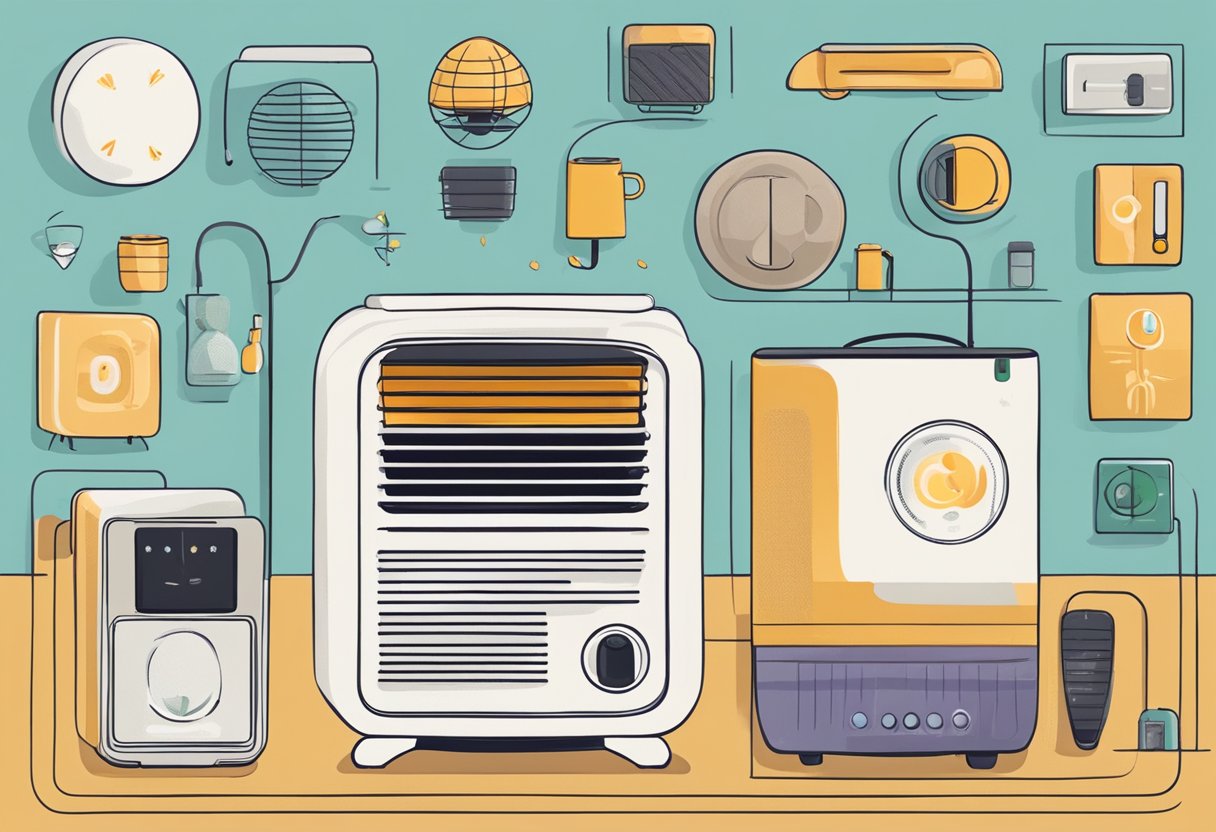
When choosing an energy-efficient space heater consider the design and size of the unit. The size of the heater will impact its energy efficiency and the amount of floor space it occupies. Smaller heaters may be easier to handle and move around, but they may not be sufficient for large rooms.
For Small Rooms:
- In a small room, you don’t need much power to maintain a comfortable temperature.
- Look for a compact heater that doesn’t take up too much floor space and has a handle for easy transportation.
- These heaters are more likely to be energy-efficient in smaller spaces, as they won’t consume excess energy to maintain warmth.
For Larger Rooms:
- Consider a heater with a more powerful output that can effectively heat the entire room.
- Ensure that the design allows for even heat distribution, such as oscillation features or built-in fans, to avoid wasting energy on uneven heating.
Types of Space Heaters:
- Ceramic space heaters are an excellent choice for spot heating.
- Oil-filled heaters can provide consistent warmth for larger rooms.
- Infrared heaters are another energy-efficient option, as they directly heat objects and people in the room instead of heating the air.
In Summary: The size and design of the space heater have a significant impact on its efficiency and performance in your room. Choose a model that meets both your room size and energy-saving needs for maximum satisfaction.
Space Heater Features That Can Improve Efficiency
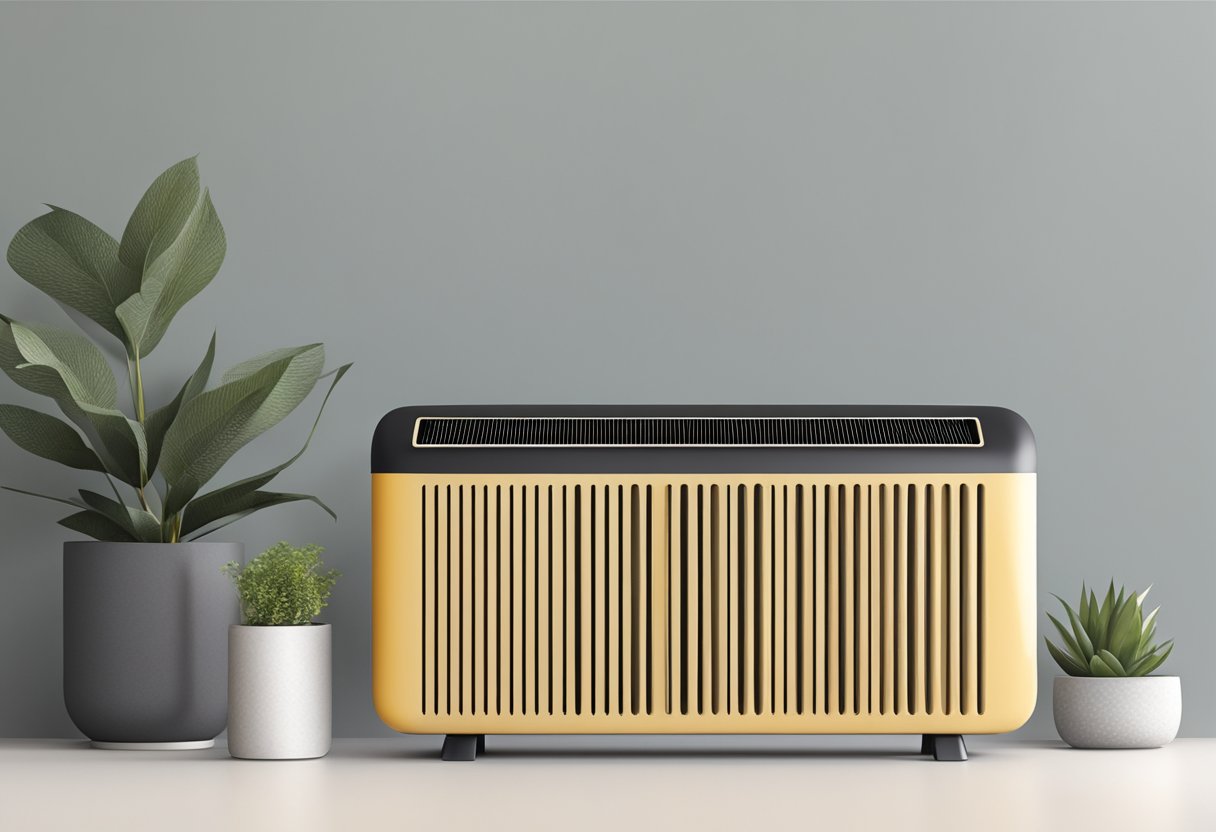
When selecting a space heater, consider models with energy-efficient features and controls to maximize your comfort and minimize energy consumption. Here are some key features to look for:
Built-in Thermostats: A built-in thermostat allows you to set your desired temperature and automatically maintains it by turning the heater on and off as needed. This helps to reduce energy usage and running costs.
Digital Thermostat: A digital thermostat provides more accurate temperature control than traditional dial thermostats. Accurate thermostats help to maintain a consistent room temperature, which reduces energy wastage.
Timer Functions: Timers allow you to pre-set the heater to turn on and off at specified times. This way, you don’t need to keep your heater running continuously and can program it to turn on just before you arrive home or switch off after you leave, conserving energy.
Oscillating Feature: Space heaters with an oscillating feature distribute heat more evenly across the room, reducing the need to crank up the thermostat. Oscillation can also help to eliminate cold spots and provide a more comfortable environment.
Remote Control: A remote control offers the convenience of adjusting the thermostat settings, timer, and oscillation function from afar, saving you from getting up to make adjustments manually. This ensures that you’re only using the heater when and where it’s necessary.
Energy-Saving Modes: Some space heaters come with energy-saving modes that help to minimize power consumption by adapting their output to the room’s temperature, like automatically lowering the heat output once the desired temperature has been reached.
Ease of Operation: Look for user-friendly space heaters with clear controls, simple programming, and easy-to-understand instructions. This will help you take full advantage of the heater’s energy-efficient features without any confusion.
Incorporating these energy-efficient features and controls into your space heater choice will result in better temperature management, energy conservation, and ultimately, lower utility bills.
Important Safety Features in Energy-Efficient Space Heaters
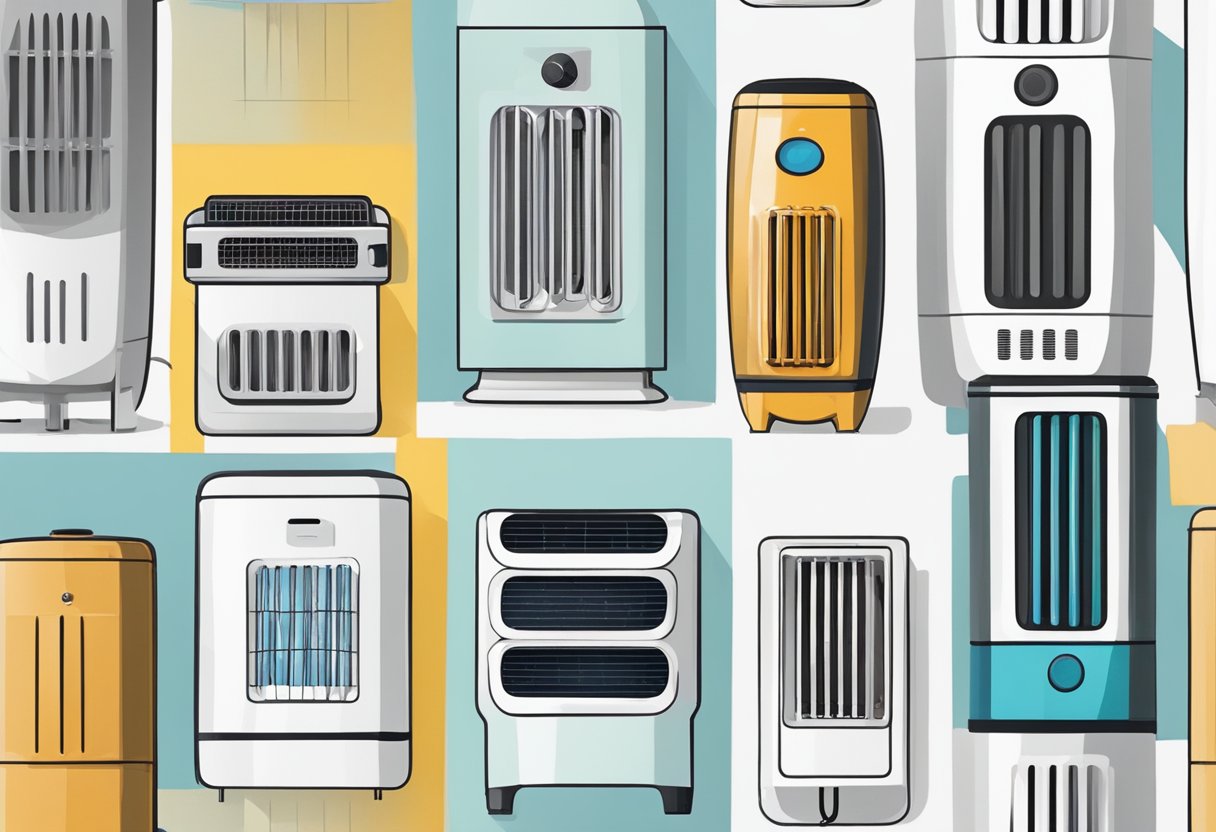
Look for space heaters with features that maximize comfort while minimizing energy use and costs. Key efficient features include:
- Built-in thermostats for automatic temperature maintenance. Digital thermostats provide more accurate control.
- Timer functions to program on/off times so heat runs only when needed.
- Oscillation to distribute heat evenly and eliminate cold spots.
- Remote controls for convenient adjustments from anywhere in the room.
- Energy-saving modes that automatically lower output once the set temperature is reached.
- User-friendly designs with simple controls and programming for full utilization of efficient capabilities.
Integrating these types of features results in improved temperature management, energy conservation, and lower utility bills through better energy efficiency.
How Room Conditions Affects Space Heater Efficiency
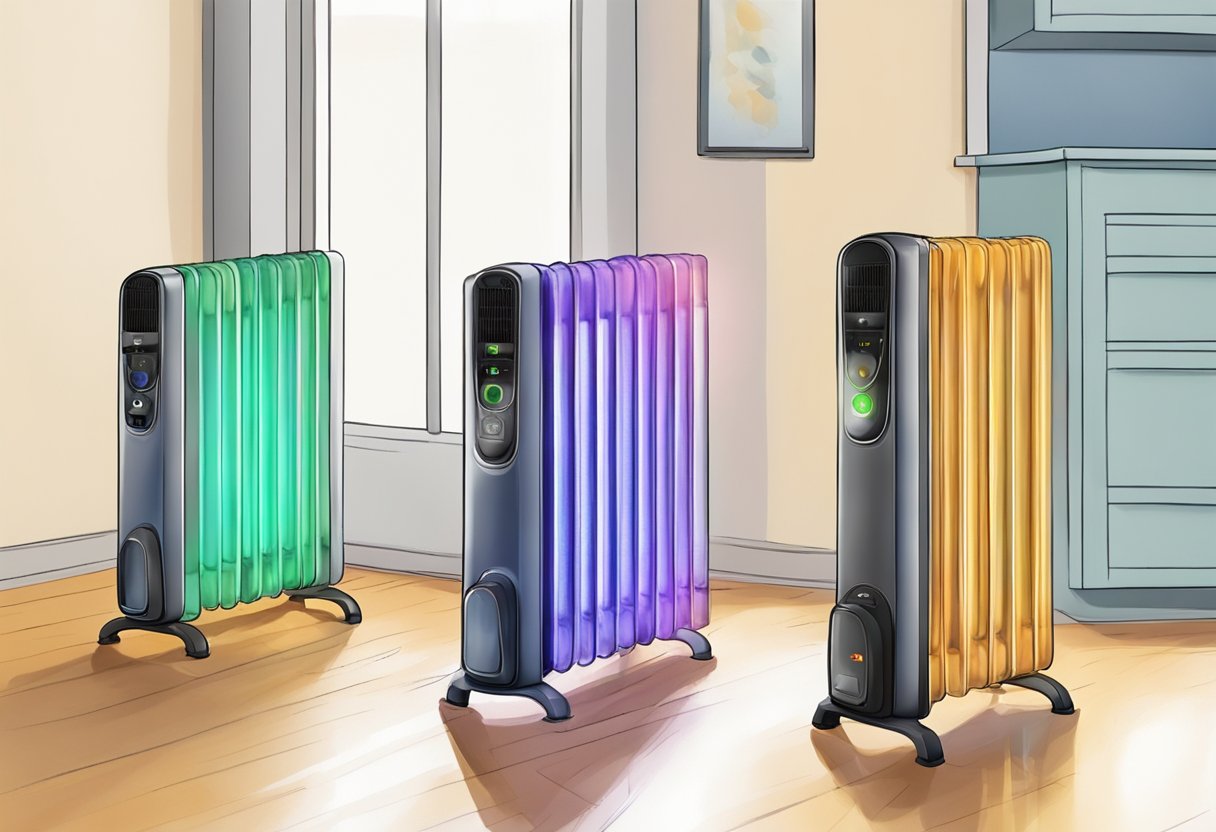
Windows and insulation impact heater effectiveness and efficiency. Larger windows and gaps allow more heat loss.
Upgrade to double/triple pane or weatherize windows and seals.
Close curtains at night to retain warmth. Insulation quality matters too.
Check walls, ceilings, and exterior areas meet standards for your climate.
Use rugs to reduce heat absorption by floors. Assessing windows and insulation allows your heater to work more efficiently at maintaining comfort while minimizing energy use and costs.
Addressing room conditions leads to better performance with space heaters.
Brands and Models of Energy-Efficient Space Heaters
In this section, we will discuss three energy-efficient space heater brands and their models: Dr. Infrared, Lasko, and Dyson. These heaters have received favorable reviews and ratings, making them great choices for individuals looking for energy-saving ways to stay warm.
Dr. Infrared Heaters
Dr. Infrared is known for designing and manufacturing high-quality, energy-efficient space heaters. One of their popular models is the Dr. Infrared Portable Space Heater. This heater uses infrared technology, which means it efficiently heats objects in a room, rather than just the air, providing longer-lasting warmth. The heater also includes features such as a 12-hour timer and a thermostat, allowing you to customize the temperature according to your needs.
Key benefits of Dr. Infrared heaters:
- Infrared technology for efficient heating
- Adjustable thermostat and timer for user convenience
- Durable and long-lasting components
Lasko Heaters
Lasko offers a variety of energy-efficient space heaters, including both ceramic and tower space heaters. One of their top models is the Lasko Electric Oscillating Ceramic Tower Space Heater. This ceramic heater has an adjustable thermostat and oscillation feature that evenly distributes warm air throughout your room. Reviews praise the Lasko heaters for their affordability and efficient heating performance.
Advantages of Lasko heaters:
- Variety of options (ceramic and tower heaters)
- Affordable choices
- Efficient heating performance
Dyson Heaters
Dyson, well-known for their innovative designs, offers energy-efficient space heaters like the Dyson HPO1 Pure Hot + Cool Air. This heater not only warms up your space but also purifies and cools the air, making it an excellent investment for year-round comfort. It comes with a variety of settings, such as a sleep timer and adjustable thermostat, catering to user preferences.
Distinguishing features of Dyson heaters:
- Advanced technology for heating, cooling, and air purification
- User-friendly settings, including sleep timer and adjustable thermostat
- Sleek designs that blend with modern interiors
When selecting an energy-efficient space heater, consider the models from these three reputable brands. All of them strive to provide quality heating solutions while minimizing energy consumption, so you can enjoy a warm and cozy environment without worrying about excessive energy bills.
Are Space Heaters More Efficient Than Central Heating?
When choosing a heating solution for your home, consider the energy efficiency of both space heaters and central systems.
Space Heaters
- Quickly provide targeted heat for small spaces
- Energy efficiency varies by model and usage
- Two main types:
- Convection heaters heat the air
- Radiant heaters warm objects/people directly
- Efficiency impacted by insulation, room size, climate
Central Heating Systems
- Furnaces and mini split heat pumps designed to heat entire home
- Generally more efficient for longer periods in larger spaces
Furnaces
- New, high-efficiency models can reach 98.5% efficiency
- Older models may only achieve 60% efficiency
Mini Split Heat Pumps
- Highly efficient, particularly in moderate climates
- Capable of both heating and cooling, saving year-round energy
- Some models up to 20 SEER efficiency
Cost Effectiveness
- Space heaters better for zone heating small areas quickly
- Central systems more efficient for whole-home heating
Maximizing Efficiency
- Proper maintenance and sizing crucial for central systems
- Insulation and sealing help retain heat, reducing consumption
In summary, the ideal choice depends on factors like room size, climate, and usage patterns. Understanding these will help you select the most energy-efficient option for your needs.
Other Space Heater Options That Are Less Efficiency
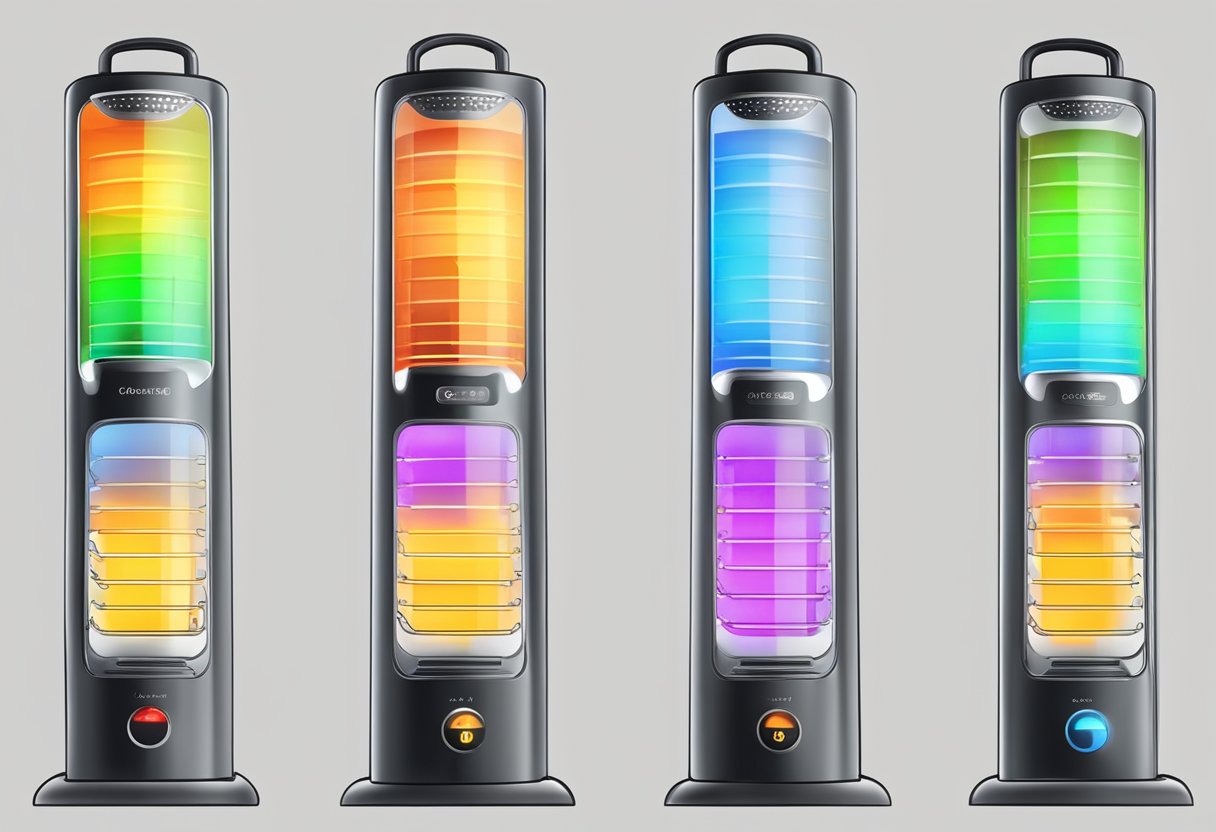
When choosing a space heater, consider alternative energy sources beyond electricity. These include propane, natural gas, and renewable energy.
Electric heaters distribute heat consistently via ceramic elements and fans. Ceramic retains heat longer, improving efficiency. However, electricity consumption increases costs.
Propane heaters offer quick warm-up and produce high BTUs per fuel unit, often making propane cheaper than electricity. Refills are readily available.
Natural gas also produces high BTUs at typically lower costs than electricity depending on location. It provides steady warmth similarly to propane.
Renewables like solar or biomass may power electric heaters depending on access. While installation costs more initially, they reduce long-term energy costs and carbon footprint.
Factors like room size, insulation, and usage patterns impact the most efficient option. Each energy type conveys benefits and tradeoffs. Understanding your needs helps determine the best choice.
Check Out Our Complete Guide to Space Heaters!
If you enjoyed this post, check out our complete guide to space heaters for more information on space heater types, safety features, troubleshooting common issues, and how to choose the right space heater for your needs!
Let Us Know How We’re Doing!
Did this expertly prepared resource answer your question?
Do you have another question about home maintenance, home improvement projects, home appliance repair, or something else?
Get more information, send in questions and keep the discussion going by contacting the I’ll Just Fix It Myself company customer service team at at 1-800-928-1490 or Email us at [email protected]
